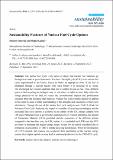Sustainability Features of Nuclear Fuel Cycle Options
Author(s)
Passerini, Stefano; Kazimi, Mujid S
DownloadPasserini-2012-Sustainability featu.pdf (2.682Mb)
PUBLISHER_CC
Publisher with Creative Commons License
Creative Commons Attribution
Terms of use
Metadata
Show full item recordAbstract
The nuclear fuel cycle is the series of stages that nuclear fuel materials go through in a cradle to grave framework. The Once Through Cycle (OTC) is the current fuel cycle implemented in the United States; in which an appropriate form of the fuel is irradiated through a nuclear reactor only once before it is disposed of as waste. The discharged fuel contains materials that can be suitable for use as fuel. Thus, different types of fuel recycling technologies may be introduced in order to more fully utilize the energy potential of the fuel, or reduce the environmental impacts and proliferation concerns about the discarded fuel materials. Nuclear fuel cycle systems analysis is applied in this paper to attain a better understanding of the strengths and weaknesses of fuel cycle alternatives. Through the use of the nuclear fuel cycle analysis code CAFCA (Code for Advanced Fuel Cycle Analysis), the impact of a number of recycling technologies and the associated fuel cycle options is explored in the context of the U.S. energy scenario over 100 years. Particular focus is given to the quantification of Uranium utilization, the amount of Transuranic Material (TRU) generated and the economics of the different options compared to the base-line case, the OTC option. It is concluded that LWRs and the OTC are likely to dominate the nuclear energy supply system for the period considered due to limitations on availability of TRU to initiate recycling technologies. While the introduction of U-235 initiated fast reactors can accelerate their penetration of the nuclear energy system, their higher capital cost may lead to continued preference for the LWR-OTC cycle.
Date issued
2012-09Department
Massachusetts Institute of Technology. Department of Nuclear Science and EngineeringJournal
Sustainability
Publisher
MDPI AG
Citation
Passerini, Stefano, and Mujid Kazimi. “Sustainability Features of Nuclear Fuel Cycle Options.” Sustainability 4, no. 12 (September 27, 2012): 2377–2398.
Version: Final published version
ISSN
2071-1050